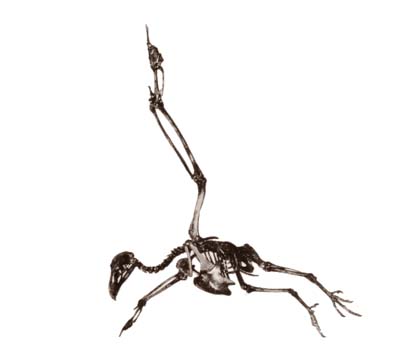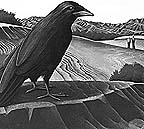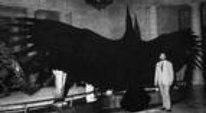In regards to references related to the Thunderbird size Giant Birds (in fact and legend) as seen over Alaska, the actual articles by the news services and newspapers have, for the most part, disappeared from the net --- primarily due to the length of time since the reported incident occurred. However, a quick search shows literally hundreds of reproductions and facsimiles (many with personal comments and updates) have shown up all over the net and can easily be found by going to the Google search engine and typing in such key words, for example, as Togiak, Manokotak, and Alaska along with the name Coupchiak, etc.

Wednesday, October 16, 2002
Southwest Alaskans say bird is the size of a small plane
ANCHORAGE -- Reports of a giant winged creature seen in Southwest Alaska in recent weeks have biolgists and residents puzzled.
Villagers in Togiak and Manokotak say the huge bird has a wingspan of about 14-feet -- the size of a small plane -- and is much bigger than anything they have seen before.
Scientists aren't sure what to make of the reports. No one doubts that people in the region west of Dillingham have seen a very large raptorlike bird. But biologists and other people familiar with big Alaska birds say they're skeptical it's that big.
A recent sighting of the mystery bird occurred last Thursday morning when Moses Coupchiak, a 43-year-old heavy equipment operator from Togiak, 40 miles west of Manokotak, saw the bird flying toward him from about two miles away as he worked his tractor.
"At first I thought it was one of those old-time Otter planes," Coupchiak said. "Instead of continuing toward me, it banked to the left, and that's when I noticed it wasn't a plane."
The bird was "something huge," he said. "The wing looks a little wider than the Otter's, maybe as long as the Otter plane."
The bird flew behind a hill and disappeared. Coupchiak got on the radio and warned people in Togiak to tell their children to stay away.
Pilot John Bouker said he was highly skeptical of reports of "this great big eagle" that is two or three times the size of a bald eagle. "I didn't put any thought into it."
But early this week while flying into Manokotak, Bouker, owner of Bristol Bay Air Service, looked out his left window and 1,000 feet away, saw a very big bird.
"The people in the plane all saw him," Bouker said. "He's huge, he's huge, he's really, really big. You wouldn't want to have your children out," Bouker said.
Raptor specialist Phil Schemf in Juneau is skeptical of the size.
"I'm certainly not aware of anything with a 14-foot wingspan that's been alive for the last 100,000 years," Schemf said.
Schemf, other biologists, a village police officer and teachers at the Manokotak School said the sightings could be of a Steller's sea eagle, a species native to northeast Asia and one of the world's largest eagles. It's about 50 percent bigger than a bald eagle.
The Steller's eagle has occasionally shown up in the Pribilof Islands, on the Aleutian chain and on Kodiak.
A bird known to be a Steller's sea eagle has been spotted three times since May and in August of last year, 40 miles up the Nushagak River from Dillingham, according to Rob MacDonald of the U.S. Fish and Wildlife Service.
Another Steller's eagle took up residence on the Taku River south of Juneau for 10 summers starting in the late 1980s, Schemf said.
The fish-eating Steller's sea eagle can weigh 20 pounds and have a wingspan of up to 8 feet. It has a distinctive and impressive appearance, Schemf said, with a pronounced yellow beak, a black or dark brown body and large white shoulder patches.
Wednesday, October 16, 2002
Pilots, villagers spot super-sized bird in Alaska
Scripps Howard News Service
ANCHORAGE, Alaska — A giant winged creature, like something out of Jurassic Park, has reportedly been sighted several times in Southwest Alaska in recent weeks.
Villagers in Togiak and Manokotak say they have seen a huge bird that’s much bigger than anything they have seen before.
A pilot says he spotted the creature while flying passengers to Manokotak last week. He calculated that its wingspan matched the length of a wing on his Cessna 207. That’s about 14 feet.
Other people have put the wingspan in a similar range.
Scientists aren’t sure what to make of the reports. No one doubts that people in the region west of Dillingham have seen a very large rapto-like bird. But biologists and other people familiar with big Alaska birds say they’re skeptical it’s that big.
A recent sighting of the mystery bird occurred Oct. 10 when Moses Coupchiak, a 43-year-old heavy equipment operator from Togiak, 40 miles west of Manokotak, saw the bird flying toward him from about two miles away as he worked his tractor.
“At first I thought it was one of those old-time Otter planes,” Coupchiak said. “Instead of continuing toward me, it banked to the left, and that’s when I noticed it wasn’t a plane.”
The bird was “something huge,” he said. “The wing looks a little wider than the Otter’s, maybe as long as the Otter plane.”
The bird flew behind a hill and disappeared. Coupchiak got on the radio and warned people in Togiak to tell their children to stay away.
Pilot John Bouker said he was highly skeptical of reports of “this great big eagle” that is two or three times the size of a bald eagle.
— Anchorage Daily News
Giant birds of prey, the Argentinian Teratorn (argentavis magnificens), as large as a man weighing 170 - 200 lbs but with wingspans of over twenty-five feet and individual wing feather lengths as long as five feet, similar in size to the feather as reported in The Boy and the Giant Feather, flew within recorded history.
For those who would question the validity of the existance of birds of such size in the first place, please see, as stated in the closing sentence of the Legend of the Giant Bird:
The loss of the Buffalo would have a devastating effect on the migratory habits of birds of such size. Not everybody makes the connection, but it is pretty simple stuff, without the herds, migration became very difficult and many of the young birds as well as some of the adults died on their way south. We are talking twenty-five foot wingspan Teratorn type birds, animals so huge they couldn't hunt in woodlands or heavy foilage. They needed large open area suchs as the Great Plains or the Argentine Pampas to navigate and hunt.
TALON AND SCRATCH MARKS FROM THE GIANT BIRD
 |
THE BEST OF CARLOS CASTANEDA |
| <<< PREV ---- LIST ---- NEXT >>> | |

(click image)